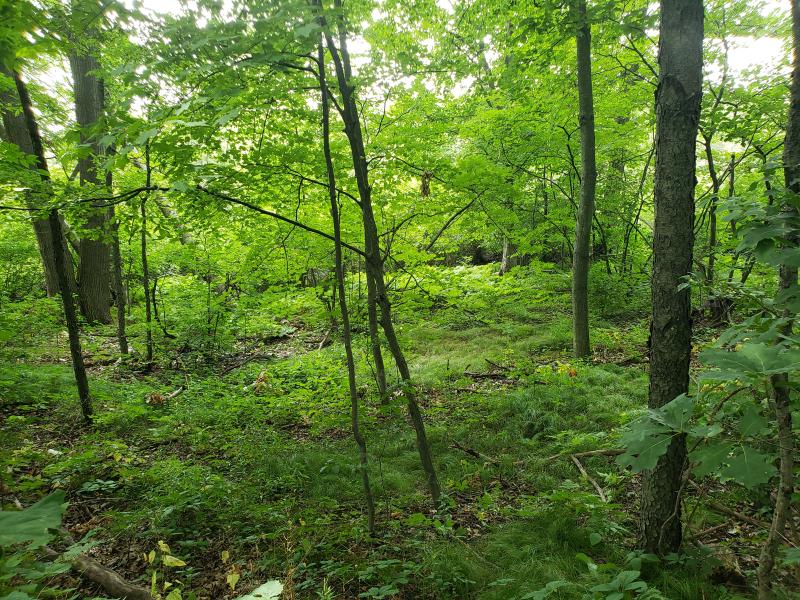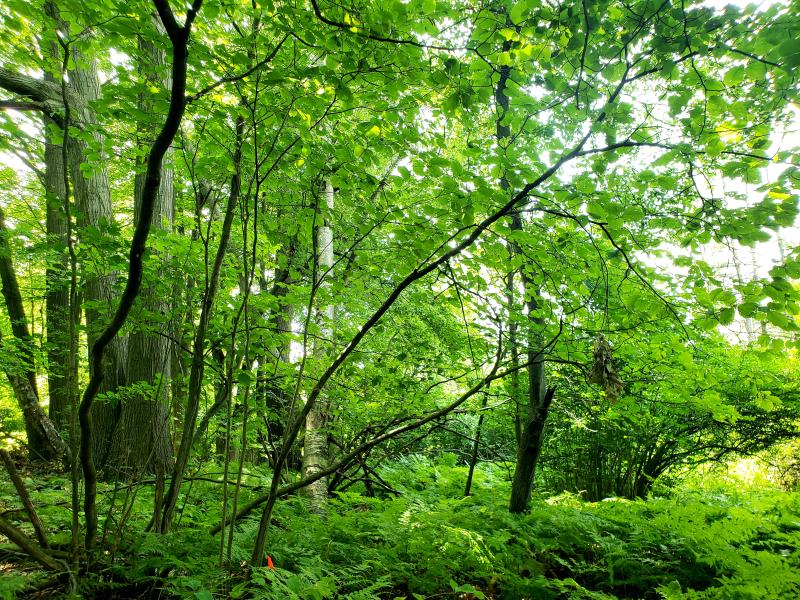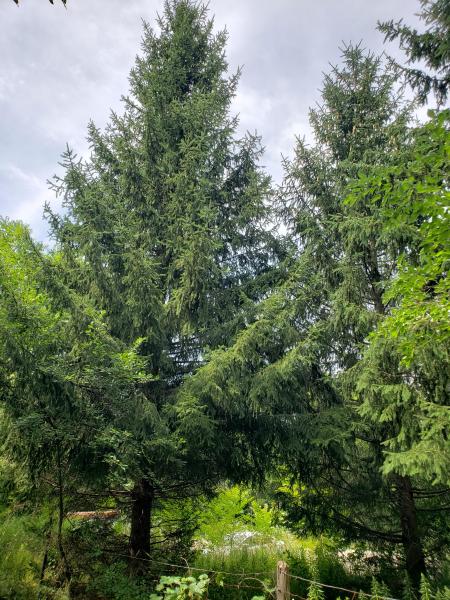
The Copetown Bog/Summit Muskeg on the Hamilton- Brantford Rail Trail
Yowisarhón:ne / Onen’tóhskon “Covered in Ice/Boreal”
Gijyahiing Agidajiw Mshkiigki
Location
GPS Coordinates
Summit Bog is a small, 27-hectare nature reserve located outside of Copetown, adjacent to the Hamilton-Brantford rail trail. It is the only bog that is known to occur in Hamilton-Wentworth County, and was formed during the last ice age, 12,000 to 18,000 years ago, when glacial scouring created a deep depression in the ground. As the glaciers retreated, the depression filled with meltwater, creating a small lake, and vegetation grew around the periphery. Dying plant matter fell and settled into the lake, and over the course of thousands of years, created a seven-meter-deep mat of peat. The leaching of organic acids from the peat creates an acidic and low nutrient environment favoring Sphagnum moss, which floats on top of the peat, and unique vegetation assemblages that are rare in southern Ontario. The bog is separated from the surrounding land by a ‘moat’ of acidic water and is inaccessible by foot but can be observed from several vantage points along the rail trail. Today, Summit Bog is managed by the Hamilton Conservation Authority, and is a popular spot for birding.
Plant species characteristic of boreal and arctic environments grow on top of the sphagnum and peat mat, including black spruce and tamarack, ericaceous shrubs such as cranberries, Labrador tea, bearberry, leather leaf and blueberries, and carnivorous plants such as pitcher plants and sundews. The Summit Bog is one of the southernmost locations where black spruce can be found in Ontario.
The land surrounding the bog is composed of deciduous forest. The southern tip of the nature reserve is home to lowland forests composed of Manitoba maple and black walnut, with a thick buckthorn and chokecherry shrub layer. Much of the understory of these forests is dominated by garlic mustard. The north end is composed of rich Carolinian forest dominated by red maple in the canopy, interspersed with musclewood, black cherry, paper birch and red oak. The shrub layer is abundant in witch-hazel, chokecherry, and honeysuckles, and also the occasional wild blueberry. The herbaceous layer is diverse, and include both native species, such as Canada mayflower, mayapple, sarsaparilla, Saint John’s wort, wintergreen, trilliums, Christmas fern, white baneberry, white snakeroot, motherwort, and greenbrier, and exotic species such as speedwell, herb Robert, and wood avens.
The Hamilton-Brantford rail trail that passes by Summit Bog today follows the route of a historic Indigenous trail called the Head-of-the-lake portage. This was an overland foot path which was used by successive groups of Indigenous peoples, including Iroquoian peoples such as the Wyandot and Attawandaron or Neutral peoples as well as the Haudenosaunee, and Anishinaabeg peoples such as the Mississaugas, to traverse from Burlington Bay to the Grand River near present day Brantford. During the 17th Century, the Seneca Nation (Haudenosaunee), were principal inhabitants of the area, and established a string of villages and outposts along the portage route to facilitate hunting and trade. The most famous of these villages was called Tinawatawa or Quinaouatoua, which was recorded in the travels of the French fur trader, René-Robert Cavelier, Sieur de La Salle. According to La Salle’s accounts, Tinawatawa was composed of 20 longhouses. The exact location of Tinawatawa was lost, but from LaSalle’s description, it is speculated to be located midway between Burlington Bay and Brantford, along Ancaster Creek from Dundas to Brantford. One proposed location is ~6 km north of Summit Bog in modern day Beverly township.
As early European settlers arrived in southern Ontario and Wentworth county, the Head of the Lake portage was first converted to roads, some of which exist today, such as Mineral Springs Road. In the late 1850s, a railroad between Toronto, Hamilton and Buffalo was built, in part, along the Head-of-Lake route. West to east, the rail-line ran from Waterford in Haldimand county through Brantford to Hamilton, and then to Smithville, where it split into two lines. One line ended in Dunnville, and the other line ended north of Wainfleet. The Summit Station, located beside Summit Bog, served as a stopping point along the rail route. Remnants of the Summit Station water tower, which drew water from the bog for use in the trains’ steam engines, can be seen today. The Toronto, Hamilton and Buffalo rail ran from 1892-1987, and despite its name, never reached Toronto or Buffalo. After it was decommissioned, the old rail beds were converted into a series of inter-city recreational trails, including the Hamilton-Brantford rail trail, which was completed in 1996.
“The Copetown Bog/ Summit Muskeg Preserve,” a short video about the ecologically significant bog, found online at: Copetown Bog.mpg - YouTube
Johnson, Lorraine. 2007. The Natural Treasures of Carolinian Canada: Discovering the Rich Natural Diversity of Ontario’s Southwestern Heartland. Carolinian Canada Coalition.
| English | Latin | Kanienʼkéha | Anishinaabemowin |
|---|---|---|---|
| Paper birch | Betula papyrifera | watenakè:taron's, watenakè:taronhs | wiigwas (singular), wiigwaasaatig (plural), wiigwaasi-mitig |
| Wild Strawberry | Fragaria virginiana Duchesne | ken’niiohontesha, niyohentéhsha’, niyohontéhsa, ken’niyohontésha | odeimin (-an, plural) |
| Black Spruce | Picea mariana | ohsó:ra | zesegaandag, gaagaagwanzh, gaagaagiwanzh, gaa'aandak, gawaandakook, inin'aandakook |
| Mayapple | Podophyllum peltatum L. | onénhotst, onénhotste, kawérhos | zhaabozigan (-an, plural), ininiwijiibik |
| Mock Strawberry | Potentilla indica Andrews (Th. Wolf) | ken’niiohontesha, niyohentéhsha’ | odeimin |
| Manitoba Maple | Acer negundo | kahwisto’kéha wáhta | adjagobi’mak |
| Red Maple | Acer rubrum | ka’takén:ra | zhiigmewanzh, zhiishiigimiiwanzh (-iik, plural) |
| White Baneberry | Actaea pachypoda | onekwénhtara niwahyò:ten, orá:tu | wiikizigan, wapkadak |
| Wild Sarsaparilla | Aralia nudicaulis | tsyotere'se'kó:wa, yonekó:wa, tsyawenséhsha, otsyawénhsa | waaboos-odji-bik, waabooz jiibik |
| Burdock | Arctium lappa | ohrohte’kó:wa | zagdebwe, zadebwe |
| Bearberry | Arctostaphylos uva-ursi | onerahtontahkó:wa | zaagaakominagaawanzh/iig “emerges like a stick - berry plant/s” |
| Jack-in-the-pulpit | Arisaema triphyllum | tyehnónhserote, kyehnónserote, kárhon, tsyorákares, tsorákares, kahnéhserote, okwá:rot nikarhonksherá:'a | zhaashaagomin |
| Paper birch | Betula papyrifera | watenakè:taron's, watenakè:taronhs | wiigwas (singular), wiigwaasaatig (plural), wiigwaasi-mitig |
| Musclewood | Carpinus caroliniana | yotenakaratí:wen | Ska’ agon-mins, Shka agonmins |
| Gray Dogwood | Cornus racemosa | tsítyete | mazh’omizh |
| Intermediate Wood Fern | Dryopteris intermedia | yetskarónhkwa, onitskerónhkwa, yetskaronhkwa'kó:wa | naanaaganashk (-oon), mzise miijim |
| Wild Cucumber | Echinocystis lobata | o’nhónhsehs | matchigiminak |
| Meadow Horsetail | Equisetum pratense | aweyó:ta | aanikawishkoons, zhiishiibinashk |
| Wild Strawberry | Fragaria virginiana Duchesne | ken’niiohontesha, niyohentéhsha’, niyohontéhsa, ken’niyohontésha | odeimin (-an, plural) |
| Wild Geranium | Geranium maculatum | tsistáhkwat | bezhigoojiibik |
| Witch Hazel | Hamamelis virginiana | takwa’aserón:ni | nsakemizins |
| Black Walnut | Juglans nigra | tsyohsò:kwak | bagaanaak |
| Tamarack | Larix laricina | kanèn:tens | mshkiigwaatik, mashkiigwaatig, mashkiig-waatik (-ook, plural) |
| Labrador Tea | Ledum groenlandicum Oeder | kanerahtóhon, onkwe’honwe akonerahtákeri | mackig'obak |
| Motherwort | Leonurus cardiaca | awerahsiyóhstha | niibiishikaabijigan |
| False Solomon’s Seal | Maianthemum racemosum | kítkit o'éta | agongseminan, agongosimizh, agong’osiminan |
| White Lettuce | Nabalus albus | ó:nyare aonón:tsi | dado’chabodji’bik |
| Catnip | Nepeta cataria | takò:s aotíhonte, takò:s kontineráhtaks | gaazha, igensibag, ga'jagens'ibag (plural) |
| Virginia Creeper | Parthenocissus quinquefolia | kontiráthens | mnidoo- biimaakwad bebaamooded |
| Black Spruce | Picea mariana | ohsó:ra | zesegaandag, gaagaagwanzh, gaagaagiwanzh, gaa'aandak, gawaandakook, inin'aandakook |
| Mayapple | Podophyllum peltatum L. | onénhotst, onénhotste, kawérhos | zhaabozigan (-an, plural), ininiwijiibik |
| Mock Strawberry | Potentilla indica Andrews (Th. Wolf) | ken’niiohontesha, niyohentéhsha’ | odeimin |
| Black Cherry | Prunus serotina | é:ri, e:ri’kó:wa, tyotyò:ren | ookweminagaawanzh, ookweminan, ikwe'mic |
| Chokecherry | Prunus virginiana | tyakonya’tawén:’eks, teyakonya’tawén:’eks | asasaweminagaawanzh, asasaweminan, baakinminaan, asasaweminogaawangh |
| Heal-all | Prunella vulgaris | yako'nikonrákhas onónhkwa, katsitsoró:kon | ingijibinaa, ogijibinaan, basi’bagak |
| Bracken Fern | Pteridium aquilinum | yetskaronhkwa'kó:wa | zhishkwedaansan, naanaaganashk (-oon), mzise miijim |
| Black Swamp Gooseberry | Ribes lacustre | tyorenatsí:yo, ohrá:ton, anáduma:o:náhi | zhaabo-miinashkoon, zhaaboomin (-aak, plural), me’skwacabo’minak, kaawe-saba |
| Red Raspberry | Rubus idaeus | skanekwen’terá:yen, skanekwen’terá:ne, skanekwenhtará:nenh | miskomin (-ak, plural) |
| Black Raspberry | Rubus occidentalis | teyoterenhá:kton, yohi'tá:ton, | miskomin (-ak, plural) |
| Bloodroot | Sanguinaria canadensis | tekanekwas, tekané:kwaks, tekanekwénhshya'ks | miskwi- chiibikoon |
| Pitcher Plant | Sarracenia pupurea | a’nó:wara aoteráhti, a’nó:wara raó:ris | o’makiki’wida’san |
| Canada Goldenrod | Solidago canadensis | otsí:nekwar niyotsi’tsyò:ten | ajidamoowaanow, waabanoominens/waabanoominensag, giizisso mashkiaki |
| Peat Moss | Sphagnum species | (check this) | asa'kamik |
| Calico Aster | Symphyotrichum lateriflorum | teyonerahtawe'éhston, yotsiron’onhkóhare orón:ya | name'gosiibag |
| Dandelion | Taraxacum officinale | tekaronhyaká:nere | mindemoyanag, doodooshaaboojiibik, mindimooyenh, wezaawaaskwaneg |
| Oval-leaved Blueberry | Vaccinium ovalifolium Sm. | karhata’kéha | miinan |
| Red Trillium | Trillium erectum | tsyonà:tsya onekwénhtara niyotsi’tsyò:ten, áhsen niioneráhtonte | moonigohn, ininiiwindibiigegan, ini'niwin'digige'gun |
| White Trillium | Trillium grandiflorum | tsyonatsyakén:ra niyotsi’tsyò:ten, tsyoná:tsik, áhsen niioneráhtonte | ininiiwindibiigegan, baashkindjibgwaan, baushkindjibgwaun, ini'niwin'digige'gun |
| Maple-leaf Viburnum | Viburnum acerifolium | karhata’kéha | miinan |
| Guelder Rose | Viburnum opulus | tó:kware | aniibiiminagaawanzh |


